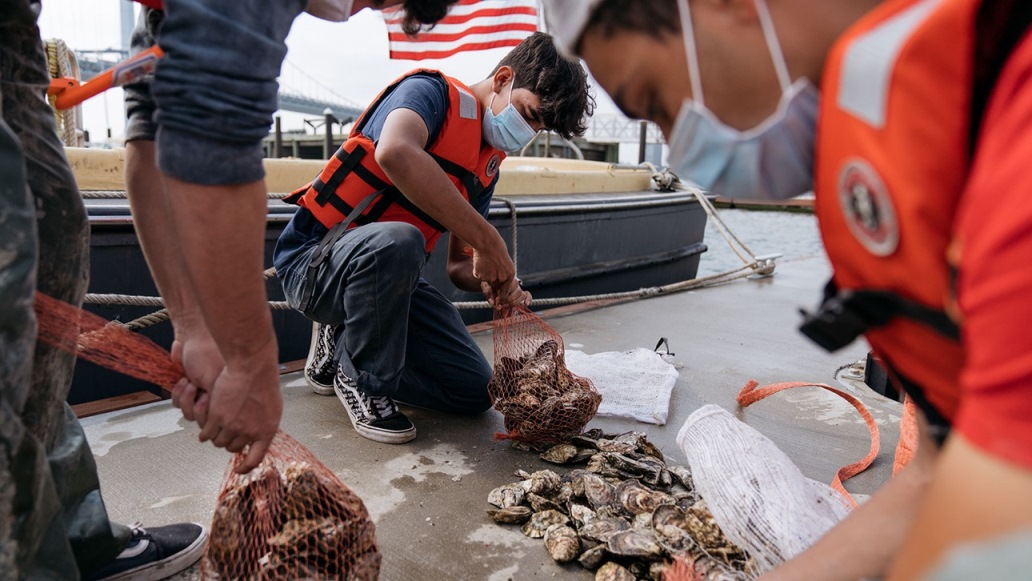At the end of May 2021, a group of New York City high school students and eager volunteers all wearing red life vests hoisted 15-pound rust-colored mesh bags into a gray motorboat in New York Harbor. Each bag contained live oysters. Really big oysters. The kind you’d almost never see at a restaurant or seafood counter.
Also on board: scuba divers.
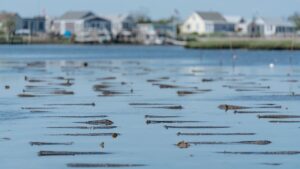 The group chugged out to Governors Island, just south of the tip of Manhattan and a stone’s throw from the western border of Brooklyn. They pulled up to a precise location in the water indistinguishable from any other—except that, 15 feet beneath the surface, steel cages sat waiting on rocks and shells.
The group chugged out to Governors Island, just south of the tip of Manhattan and a stone’s throw from the western border of Brooklyn. They pulled up to a precise location in the water indistinguishable from any other—except that, 15 feet beneath the surface, steel cages sat waiting on rocks and shells.
The divers jumped into the water, and the team on board tied a long cord to the bags and heaved them into the murky water, where the divers pulled the bags under water and placed them into what they call “oyster condos.” The sacks will eventually dissolve, and the oysters will live out their lives much like oysters in the wild.
That late spring day was the culmination of an effort put together in response to the COVID-19 pandemic in less than a year by The Pew Charitable Trusts and The Nature Conservancy, which has been at the forefront of oyster restoration around the world. In October 2020 the two organizations turned an anonymous donation into a program called Supporting Oyster Aquaculture and Restoration (SOAR).
With guidance and support from federal and state agencies and industry leaders, SOAR brings oyster growers and restoration experts together. Its goal is twofold: helping oyster farmers and rebuilding oyster reefs, a well-tested remedy to regenerate oyster populations and offset the decimation of the important marine bivalves that provide an essential role in keeping waters clean.
In its first year, SOAR bought nearly $2 million worth of overgrown—and no longer commercially viable—oysters from farmers in New England, the mid-Atlantic, and Washington state with the goal of returning those oysters to the water.
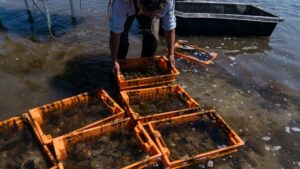 “Oyster farmers expected 2020 to be a banner year, but by March many were bracing for the worst,” says Aaron Kornbluth, who works on Pew’s conserving marine life in the U.S. project. “When COVID hit and restaurants shut down, we realized it would have an outsized impact on farmers, who supply 95% of the world’s oysters. Many were afraid they wouldn’t be able to survive.”
“Oyster farmers expected 2020 to be a banner year, but by March many were bracing for the worst,” says Aaron Kornbluth, who works on Pew’s conserving marine life in the U.S. project. “When COVID hit and restaurants shut down, we realized it would have an outsized impact on farmers, who supply 95% of the world’s oysters. Many were afraid they wouldn’t be able to survive.”
Even more alarming to farmers, their oysters continued to grow. Restaurants and other commercial outlets don’t want huge oysters; the ideal slurping size is about 2.5 to 3 inches long, aesthetically appealing while ensuring a smooth ride down the gullet. What were growers going to do with what some have called “big uglies”—which no one wanted to buy, let alone eat?
“I wasn’t sure we would make it in that moment of isolation, feeling of powerlessness, and uncertainty,” says Sue Wicks, a former professional basketball player who now owns Violet Cove Oysters in Moriches Bay on Long Island. There was “so much bad news,” she says, “and aquaculture wasn’t on anybody’s priority list.”
SOAR’s oyster purchase relieved Wicks’ anxiety about her too-big mollusks, which were taking up more and more of her farm’s limited space. It also allowed her to keep paying her employees throughout the winter, the most difficult time for farmers to make payroll even in a good year. SOAR’s intervention “made all the difference in the world,” she says. “It not only strengthened our financial situation, it uplifted my spirt. That unexpected helping hand and encouragement continues to be my bright moment of the COVID era.”
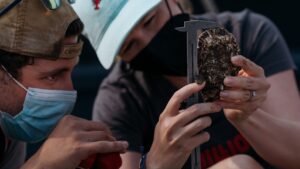 But buying the oysters from grateful farmers was only the first step. SOAR simultaneously teamed up with experienced oyster reef restoration organizations such as Billion Oyster Project, a nonprofit that restores oysters to New York Harbor through education initiatives, to bring the overgrown shellfish back home to their native habitats, where they could do what they do best for the waters and the sea life in them.
But buying the oysters from grateful farmers was only the first step. SOAR simultaneously teamed up with experienced oyster reef restoration organizations such as Billion Oyster Project, a nonprofit that restores oysters to New York Harbor through education initiatives, to bring the overgrown shellfish back home to their native habitats, where they could do what they do best for the waters and the sea life in them.
“For fish, an oyster reef provides a nice secure house and a well-stocked fridge,” says Boze Hancock, senior marine habitat restoration scientist at The Nature Conservancy. “You see an explosion of biodiversity of forage species around oyster reefs.”
This rich environment also draws turtles and shorebirds, plus red drum, flounder, striped bass, and trout—and with them, tourism and commercial and recreational fishing, which means, of course, jobs.
Before the turn of the 20th century, oysters—with their key role in keeping waters clear and clean and providing habitat for marine species—were nearly synonymous with New York City. The harbor teemed with Blue Point oysters, which were sold around the world and used to pave roads, burned for lime, and served to eager customers on city streets. But pollution, sewage, and industrial-scale overharvesting nearly killed them off, and today the East Coast population is about 10% of its historic size. Most of the oysters that we eat in restaurants or buy in grocery stores now are farm-raised.
But restored oyster reefs, such as the ones SOAR helps create, can continue to provide benefits to waters and marine wildlife—and to fill restaurant menus. According to the National Oceanic and Atmospheric Administration, restoration projects in the Chesapeake Bay are helping clear that estuary by filtering nitrogen out of the water with 95% of reefs surveyed in Maryland meeting scientists’ definition of successful restoration.
The oyster condos in New York Harbor are doing their jobs, too. Billion Oyster Project, which now has 15 reef sites, measured the water filtration capacity of the oysters on its newly created reefs and found that they have relatively the same efficiency as oysters on longer established ones, says Katie Mosher, the organization’s senior director. “We’ve seen positive changes in the benthic habitat over time. In and around the reefs, we see abundant and interesting creatures such as starfish, anemone, crabs, many kinds of fish species, and all sorts of other filter-feeding species like barnacles, mussels, and tunicates.”
And the rejuvenated oyster reefs benefit more than the water and marine life: They’re also a teaching tool to expose city kids to environmental issues.
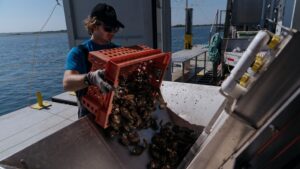 “One of the most exciting changes for us is to see young people in the water, identifying all these critters with us, and measuring the changes in water quality,” Mosher says. “Our work is as much about providing access for people in an urban environment, and that change is so gratifying to watch.”
“One of the most exciting changes for us is to see young people in the water, identifying all these critters with us, and measuring the changes in water quality,” Mosher says. “Our work is as much about providing access for people in an urban environment, and that change is so gratifying to watch.”
SOAR expects to support more than 125 oyster farms and more than 450 jobs in Maine, Maryland, Massachusetts, New Hampshire, New Jersey, New York, and Washington. At the same time, those nearly 4 million oysters will help rebuild 40 acres of imperiled native shellfish reefs across 25 restoration sites.
In the future, SOAR hopes to create a permanent market for oyster restoration projects to buy the big uglies, which are usually about 15% to 20% of a farmer’s production. The hypothesis is that larger oysters are better than the smaller, commercially viable specimens for reef restoration projects because their thicker shells guard against predators—and because they create bigger spawns and filter more water.
“Although big, farmed adult oysters have rarely been used for reef restoration—past projects mostly used baby oysters—this is exciting from a biological standpoint,” says Pew’s Kornbluth.
So although oyster connoisseurs don’t want the big uglies, the giants have a valuable role to play in the country’s inlets and bays, cleaning the waters and strengthening fragile coastal ecosystems just as nature intended.
All photos are courtesy of Lexey Swall / The Pew Charitable Trusts.
This article was written by Carol Kaufmann, and originally appeared on the website of the Pew Charitable Trusts. Reprinted here by permission.

